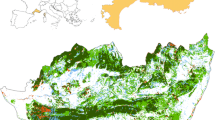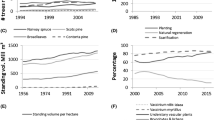Abstract
Fallow vegetation within landscapes dominated by shifting cultivation represents a woody species pool of critical importance with considerable potential for biodiversity conservation. Here, through the analysis of factors that influence the early stages of fallow vegetation regrowth in two contrasting forest margin landscapes in Southern Cameroon, we assessed the impact of current trends of land use intensification and expansion of the cultivated areas, upon the conservation potential of shifting cultivation landscapes. We combined the analysis of plot and landscape scale factors and identified a complex set of variables that influence fallow regrowth processes in particular the characteristics of the agricultural matrix and the distance from forest. Overall we observed a decline in the fallow species pool, with composition becoming increasingly dominated by species adapted to recurrent disturbance. It is clear that without intervention and if present intensification trends continue, the potential of fallow vegetation to contribute to biodiversity conservation declines because of a reduced capacity, (1) to recover forest vegetation with anything like its original species composition, (2) to connect less disturbed forest patches for forest dependent organisms. Strategies to combat biodiversity loss, including promotion of agroforestry practices and the increase of old secondary forest cover, will need not only to operate at a landscape scale but also to be spatially explicit, reflecting the spatial pattern of species reservoirs and dispersal strategies and human usage across landscapes.






Similar content being viewed by others
References
Achard F, Eva HD et al (2002) Determination of deforestation rates of the worlds humid tropical forest. Science 297 no. 5583. Special features on sustainable development pp 999–1002
Ambrose-Oji B (2003) The contribution of NTFPs to the livelihoods of the ‘forest poor’: evidence from the tropical forest zone of south-west Cameroon. International Forestry Review 5:2
Angelsen A (ed) (2008) Moving ahead with REDD: issues, options and implications. CIFOR, Bogor, Indonesia, p 156
ASB, Alternative to Slash and Burn program. http://www.asb.cgiar.org
Brown D (2006) Personal preferences and intensification of land use: their impact on southern Cameroonian slash-and-burn agroforestry systems. Agroforestry Systems 68(1):53–67
Burgers P, Hairiah K, Cairns M (2000) Indigenous fallow management. Lecture Note 4. International Center for Research in Agroforestry, South East Asian Research Programme, Bogor, Indonesia
Carrière SM, Letourmy P, McKey DB (2002) Effects of remnant trees in fallows on diversity and structure of forest regrowth in a slash-and-burn agricultural system in southern Cameroon. Journal of Tropical Ecology 18:375–396
Chazdon RL (2003) Tropical forest recovery: legacies of human impact and natural disturbances. Perspectives in Plant Ecology, evolution and systematics. 6:51–71
Dalle SP, De Blois S (2006) Shorter fallow cycles affect the availability of noncrop plant resources in a shifting cultivation system. Ecology and Society 11(2):2. http://www.ecologyandsociety.org/vol11/iss2/art2/
De Rouw A (1994) Effect of fire on soil, rice, weeds and forest regrowth in a rain forest zone (Cote d’Ivoire). Catena 22:133–152
De Rouw A (1995) The fallow period as a weed break in shifting cultivation (tropical wet forests). Agriculture Ecosystem and Environment 54:31–43
de Wasseige CDD, de Marcken P, Eba’a Atyi R, Nasi R, Mayaux Ph (2009) Les Forêts du Bassin du Congo—Etat des Forêts 2008. Office des publications de l’Union européenne 2009:426
Duncan SR, Chapman CA (1999) Seed dispersal and potential forest succession in abandoned agriculture in tropical Africa. Ecological Applications, Ecological Society of America 9(3):998–1008
Ewers RM, Didham RK (2006) Confounding factors in the detection of species responses to habitat fragmentation. Biological Reviews 81(1):117–142
FAO (2001) Global forest resource assessment 2000. Main report. FAO Forestry Paper No. 140. FAO, Rome, Italy
Ferguson BG, Vandermeer J, Morales H, Griffith MD (2003) Post-Agricultural Succession in El Petén, Guatemala. Conservation Biology 17(3):818–828
Finegan B, Nasi R (2004) The biodiversity and conservation potential of shifting cultivation landscapes. In: Schroth G, da Fonseca GAB, Harvey CA, Gascon C, Vasconcelos HL, Izac AMN (eds) Agroforestry and biodiversity conservations in tropical landscapes. Island Press, Washington, DC, USA
Gockowski J, Tonye J, Baker D, Legg C, Weise S, Ndoumbé M, Tiki-Manga T, Fouaguégué A (2004) Characterization and diagnosis of farming systems in the forest margins benchmark of Southern Cameroon. IITA Social Sciences Working Paper No 1. Ibadan, Nigeria
Gotelli NJ, Colwell RK (2001) Quantifying biodiversity: procedures and pitfalls in the measurement and comparison of species richness. Ecology Letters 4:379–391. http://www.blackwell-synergy.com/doi/abs/10.1046/j.1461-248.2001.00230.x
Hardesty BD, Parker T (2002) Community seed rain patterns and a comparison to adult community structure in a West African tropical forest. Plant Eoclogy 164:49–64
Hawthorne WD (1996) Holes and the sums of parts in Ghanaian forest: regeneration, scale and sustainable use. In Swaine MD, Alexander IJ, Watling R (eds) Studies in Guinea-Congo rain forest. Proceedings of the Royal Society, Edinburgh 104b:75–176
Kahn F (1982) La reconstitution de la forêt tropicale apres culture traditionnelle (sud-ouest de la Côte-d’Ivoire). Memoire ORSTOM, Paris, France
Kent M, Coker P (1992) Vegetation description and analysis: a practical approach. CRC Press, Boca Raton; Belhaven Press, London, pp 363
Kindt R, Coe R (2005) Tree diversity analysis. A manual and software for common statistical methods for ecological and biodiversity studies. World Agroforestry Centre (ICRAF), Nairobi
Kindt R, Van Damme P, Simons AJ, Beeckman H (2006) Planning tree species diversification in Kenya based on difference in tree species composition between farms. I. Analysis of tree uses. Agroforestry Systems 67:215–228
Kotto-Samè J, Woomer PL, Moukam A, Zapfack L (1997) Carbon dynamics in slash-and-burn agriculture and land use alternatives of the humid forest zone in Cameroon. Agriculture Ecosystems and Environ. 65(3):245–256
Kupfer JA, Webbeking AL, Franklin SB (2004) Forest fragmentation affects early successional patterns on shifting cultivation fields near Indian Church, Belize. Agriculture Ecosystems and Environment 103:509–518
Kupfer JA, Malanson GP, Franklin SB (2006) Not seeing the ocean fort he islands: the mediating influence of matrix based processes on forest fragmentation effects. Globale Ecology and Biogeography 15:8–20
Lawrence D (2004) Erosion of tree diversity during 200 years of shifting cultivation in Bornean rain forest. Ecological Applications, the Ecological Society of America. 14:1855–1869
Legendre P, Legendre L (1998) Numerical ecology. 2nd English edn. Elsevier, Amsterdam
Letouzey R (1985) Notice de la carte phytogeographique du Cameroun au 1:500.000. Institut de la Carte Internationale de la Végétation, Toulouse, France
Makana JR, Thomas SC (2006) Impacts of selective logging and agricultural clearing on forest structure, Floristic composition and diversity, and timber tree regeneration in the Ituri Forest, Democratic Republic of Congo. Biodiversity and Conservation 15:1375–1397
McCune B, Grace JB (2002) Analysis of ecological communities. MjM Software, Oregon, Gleneden Beach, USA
McGarigal K, Marks BJ (1995) FRAGSTATS: spatial pattern analysis program for quantifying landscape structure. General Technical Report PNW-351, USDA Forest Service
McGrath DG (1987) The role of biomass in shifting cultivation. Human Ecology 15:221–242
Mertens B, Sunderlin W, Ndoye O, Lambin EF (2000) Impact of macro economic change on deforestation in South Cameroon: integration of household survey and remotely-sensed data. World Development 28(6):983–999
Mertz O (2009) Trends in shifting cultivation, and the REDD mechanism. Current Opinion in Environmental Sustainability 1(2):156–160
Mitja D, Hladik A (1989) Aspects de la reconstitution de la végétation dans deux jachères en zone forestière humide (Makokou, Gabon). Acta Oecologica/Oecologia Generalis 10:75–94
Ndam N (1998) Tree regeneration, vegetation dynamics and the maintenance of biodiversity on Mount Cameroon: the relative impact of natural and human disturbance. PhD Thesis, University of Wales, Bangor, UK
Nepstad DC, Uhl C, Pereira CA, Cardoso da Silva JM (1996) A comparative study of tree establishment in abandoned pastures and mature forest of Eastern Amazonia. Oikos 76(1):25–39
Ngobo MP (2002) Ecology and socio-economic importance of short fallows in the humid forest zone of Southern Cameroon. PhD Thesis, University of Wales, Bangor, UK
Ngobo M, McDonald MA, Weise S (2004) Impacts of type of fallow and invasion by Chromolaena odorata on weed communities in crop fields in Cameroon. Ecology and Society 9(2):1
Norgrove L, Hauser S, Weise S (2001) Response of Chromolaena odorata to timber tree densities in an agrisilvicultural system in Cameroon: aboveground biomass, residue decomposition and nutrient release. Agriculture Ecosystems and Environment 81(3):191–207
Nounamo L, Yemefack M (2002) Farming systems in the evergreen forest of southern Cameroon: shifting cultivation and soil degradation. Tropenbos Cameroon Documents 8, Kribi, Cameroon
Oksanen J, Kindt R, Legendre P, O’Hara RB (2007) Vegan: community ecology package Version 1.8–6. http://cran.r-project.org/
Padoch C, Coffey K, Mertz O, Leisz SJ, Fox J, Wadley RL (2005) The Demise of Swidden in Southeast Asia? Local Realities and Regional Ambiguities. Danish Journal of Geography 107(1):29–41
Palm CA, van Nordwijk M, Woomer PL, Alegre JC, Arevalo L, Castilla CE, Cordeiro DG, Hairiah K, Kotto-Samè J, Moukam A, Parton WJ, Ricse A, Rodrigue V, Sitompul SM (2005) Carbon losses and sequestration following land use change in the humid tropics. In: Palm CA, Vosti SA, Sanchez PA, Ericksen PJ, Juo ASR (eds) Slash and burn: the search for alternatives. Columbia University Press, New York, NY, USA
PC-ORD. Multivariate Analysis of Ecological Data. Version 4.34. MjM Software, Gleneden Beach, Oregon, USA
Poorter L, Bongers F, Kouame FN, Hawthorne WD (eds) (2004) Biodiversity of West African forests. An ecological atlas of woody plant species. CABI Publishing, Oxford, UK, p 528
R Development Core Team (2007) R: A language and environment for statistical computing. R Foundation for Statistical Computing, Vienna, Austria. http://www.R-project.org
RI ES (1999) ArcGIS v9.2. Redlands CA, USA
Robiglio V (2008) Beyond slash and burn: landscape ecology of shifitng cultivation systems in Southern Cameroon. PhD Thesis, University of Wales, Bangor, UK
Swallow B, van Noordwijk M, Dewi S, Murdiyarso D, White D, Gockowski J, Hyman G, Suseno B, Robiglio V, Meadu V, Ekadinata A, Agus F, Hairiah K, Mbile P, Sonwa DJ, Weise S (2007) Opportunities for avoided deforestation with sustainable benefits. An Interim Report by the ASB Partnership for the Tropical Forest Margins. ASB Partnership for the Tropical Forest Margins, Nairobi, Kenya, 42 p
Tabachnick BG, Fidell LS (2007) Using multivariate Statistics. 5th edn, Pearson International edn. Boston, USA
Tchouto MGP (2004) Plant diversity in a Central African rain forest: implications for biodiversity conservation in Cameroon. PhD Thesis, Wageningen University
Toledo VM, Ortiz-Espejel B, Cortés L, Moguel P, Ordoñez MDJ (2003) The multiple use of tropical forests by indigenous peoples in Mexico: a case of adaptive management. Conservation Ecology 7(3):9. http://www.consecol.org/vol7/iss3/art9/
TREES (1995) Study of forest/non-forest interface. Typology of fragmentation of tropical forest. CEC/ISPRA Joint Research Centre Trees Series B: Research Report No. 2. Joint Research Center, European Space Agency, Luxemburg
TREES (1998) Identification of deforestation hot spot areas in the humid tropics. CEC/ISPRA Joint Research Centre Trees Series B: Research Report No. 4. Joint Research Center, European Space Agency, Luxemburg
Uhl C (1987) Factors controlling succession following slash-and-burn agriculture in Amazonia. The Journal of Ecology 75(2):377–407
van Noordwijk M (2002) Scaling trade-offs between crop productivity, carbon stocks and biodiversity in shifting cultivation landscape mosaics: the FALLOW model. Ecological Modelling 149:113–126
Vivien J, Faure JJ (1989) Arbres des Forets Denses d'Afrique Centrale. Especes du Cameroun. Republique francaise; Ministere des Relations Exterieures, de la Cooperation et du Developpement. Agence de Cooperation Culturelle et Technique
Youta H (1998) Arbres contre graminee: la lente invasion de la savane par la foret au Centre-Cameroun. Thesis. Universite de Paris-Sorbonne, Pparis IV, u.f.r. de geographie et amenagement. Paris, France
Zimmermann JK, Pascarella JB, Aide TM (2000) Barriers to forest regeneration in and abandoned pasture in Puerto Rico. Restoration Ecology 8(4):350–360
Acknowledgments
The authors acknowledge ASB, the Alternative to Slash and Burn program at the World Agroforestry Centre (ICRAF) Nairobi for assisting in the accomplishment of this research project. We also acknowledge funding from the Italian Foreign Ministry that covered the costs of work in Cameroon at the International Institute of Tropical Agriculture (IITA) Regional Station in Yaoundé. The study was part of a PhD degree within the School of the Environment and Natural Resources, Bangor University, UK. Thanks to the two anonymous reviewers and the editors for their comments and guiding.
Author information
Authors and Affiliations
Corresponding author
Appendices
Rights and permissions
About this article
Cite this article
Robiglio, V., Sinclair, F. Maintaining the Conservation Value of Shifting Cultivation Landscapes Requires Spatially Explicit Interventions. Environmental Management 48, 289–306 (2011). https://doi.org/10.1007/s00267-010-9611-2
Received:
Accepted:
Published:
Issue Date:
DOI: https://doi.org/10.1007/s00267-010-9611-2




